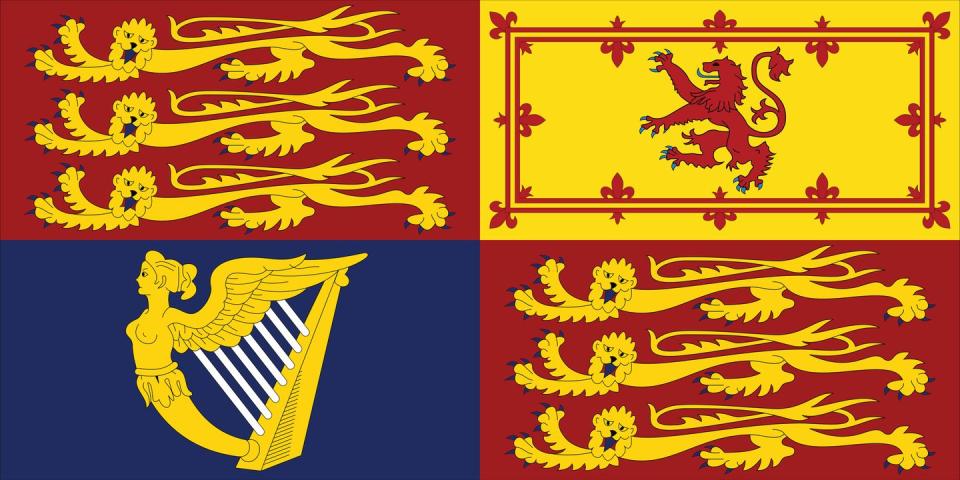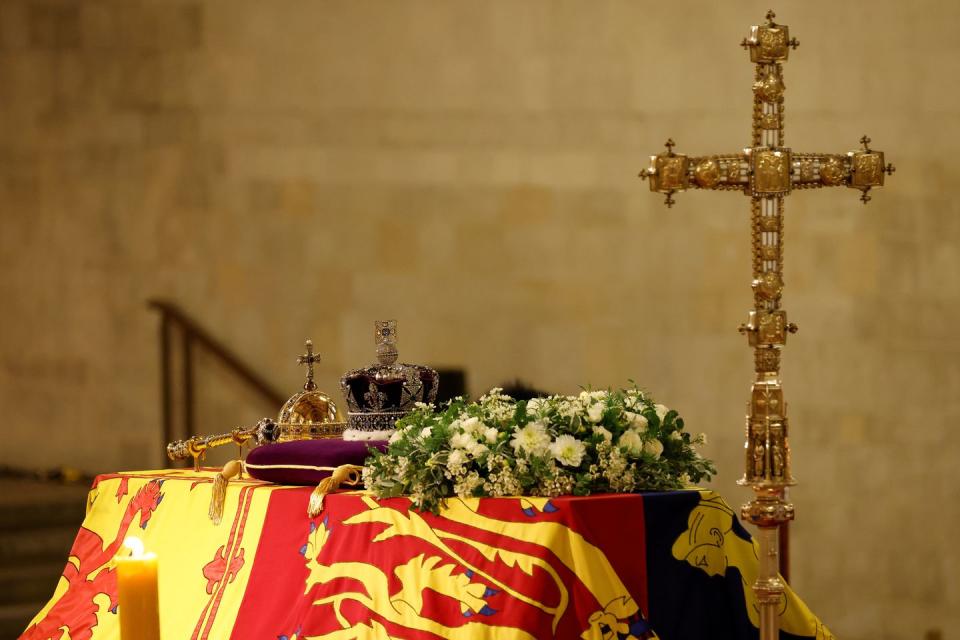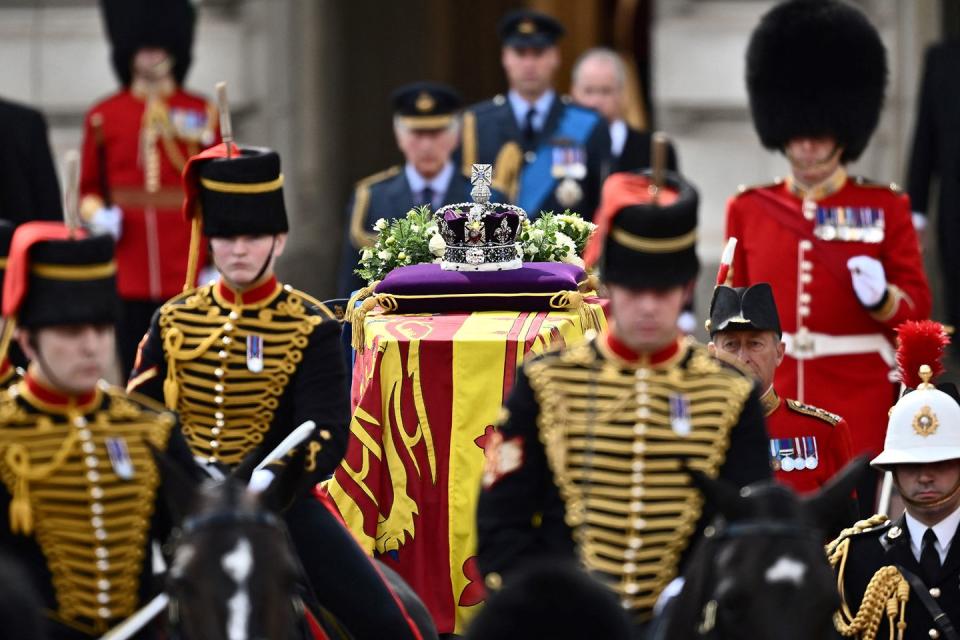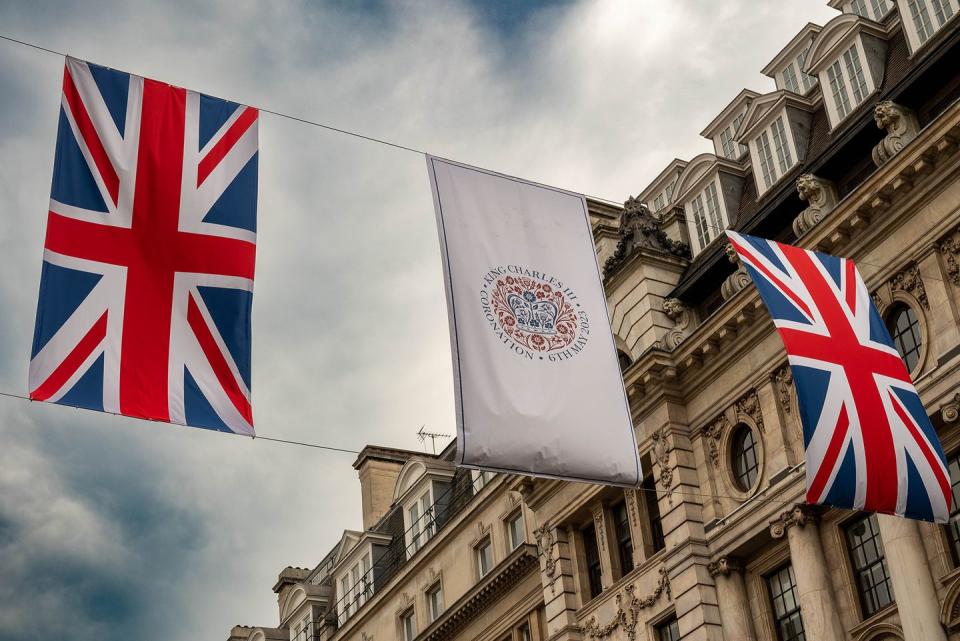How the royal standard flag is made and what its symbols mean

The Royal Standard flag bears the Royal coat of arms and was the flag of Queen Elizabeth II during her reign as monarch.
Representing the sovereign and UK, the symbolic flag has now passed to King Charles III and we’re likely to see the Royal Standard flown at Buckingham Palace and Windsor over the coronation weekend (6-8 May).
Flown when the King is in residence at a royal palace, it’s also flown on official car journeys and planes, when grounded. The royal family website says can also be flown from buildings when the King makes an official visit, unless it’s a church or other ecclesiastical building.
However, it's never flown at half-mast like the Union Jack, as even when a Monarch passes away there is still a Sovereign.
Here, we take a look at how the Royal Standard flag – also referred to as the Standard – is made and what the design signifies.
What do the symbols mean on the Royal Standard Flag?

Split into four quadrants, the first and fourth quadrants feature three lions in yellow on a red background, representing England. Scotland is in the second quadrant with a red lion on a yellow background and Ireland's arms are represented by a yellow harp on a blue backdrop in the third quarter.
If you're wondering why Wales isn't represented on the Royal Standard flag, the official Royal family site says this is because, "its special position as a Principality was recognised by the creation of the Prince of Wales long before the incorporation of the quarterings for Scotland and Ireland in the Royal Arms".
The Scottish version of the Royal Standard sees the Scottish and English arms switch positions – so the Scottish emblem is in the first and fourth quadrants and the English in the second.
The Royal Standard flag at the Queen’s funeral
When Queen Elizabeth II passed away on Thursday 8 September 2022, the flag took on extra pertinence as a large Royal Standard flag was carefully draped over the late Queen's coffin.
The Queen was lying-in-state in Westminster Hall from Wednesday 14 September, allowing mourners to pay their respects before her state funeral on Monday, 19 September at Westminster Abbey.
In the magnificence of Westminster Hall, the Queen's coffin rested on a raised platform called a catafalque. Draped in the Royal Standard, the Imperial Crown, the sovereign's orb and sceptre were rested on top, along with a floral wreath, reported the BBC.

The Queen's coffin, draped in the Standard, was carried from the catafalque to the gun carriage which was pulled by members of the Royal Navy to Westminster Abbey for the state funeral which began at 11 am (BST).
Following the service, the funeral procession travelled from Westminster Abbey to Wellington Arch, where the Queen's coffin was transferred to a hearse for her final journey to Windsor.
A committal took place at 4pm at St George's Chapel, Windsor before the Queen was laid to rest during a private family service taking place at 7.30pm.
How is the Royal Standard flag made?
Flying Colours Flagmakers, based in Knaresborough, North Yorkshire has been making flags for the Royal family since 2000 and has held a Royal Warrant since 2008. Last year, owner Andy Ormrod spoke to Prima about what was involved in making the Royal Standard flag for the Queen's funeral.
Three people from the 18-strong company were involved in making the special flag, each taking care of a specific part of the process.
The first step involves printing a faint outline of the design onto the four quadrants of the flag. For the Royal Standard draped over the Queen’s coffin, each quadrant measured 3 foot by 6 foot.

Using a zigzag stitch on a sewing machine, fabric is then appliquéd on to create the design.
"When they’ve done that, they’ll trim off the excess fabric," says Andy. "It’s like a mosaic. The whole flag is 12 ft by 6ft. You work on each quarter at a time."
This intricate appliqué work is done by a single person to ensure consistency across the flag. "You have your own particular style of handwriting and it’s the same with sewing machines – people sew differently," he explains. "One person does most of the work."
Once appliquéd the four quarters are joined together using a flat felled seam.
"It’s folding two pieces a fabric together and they make a seam," says Andy. "It grabs the fabric twice and it’s stitched twice. It has to be very straight. Then it’s squared off again and hemmed all round."
Andy explains that it's difficult to create in one go. "Your eyes go funny with all the designs so it’s manufactured over a period of time," he says.
How is the Union Jack flag made?

We're likely to see plenty of Union Jack flags and bunting in the UK over the weekend as the country celebrates the coronation
The Union Jack, or Union Flag, combines the crosses of three countries under one sovereign, states the Royal Family website.
It combines the kingdoms of England and Wales, of Scotland and of Ireland, although only Northern Ireland has been part of the United Kingdom since 1921.
The three heraldic crosses on the flag are:
The cross of Saint George, patron saint of England: A red cross on a white background.
The cross saltire of Saint Andrew, patron saint of Scotland: A diagonal white cross on a blue background
The cross saltire of Saint Patrick, patron saint of Ireland: A diagonal red cross on a white background.
Because the Union Flag was created in 1606, when the Principality of Wales was already united with England, the Welsh Dragon doesn’t appear on the Union Jack.
In contrast to the Royal Standard, the Union Jack is made without appliqué.
"The Union Flag is all sewn so 31 pieces of fabric all stitched together," says Andy. "The largest Union flag flown in this country is flown at Windsor Castle. 38ft by 19ft. And it’s made by us."
You Might Also Like


